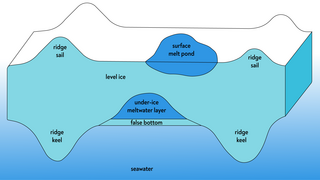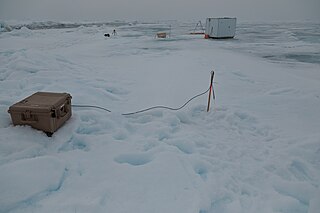
Matthew David Shupe (born around 1975 in Washington, D.C., US) is an American mathematician, chemist, meteorologist and climatologogist. [1] [2] [3]

Matthew David Shupe (born around 1975 in Washington, D.C., US) is an American mathematician, chemist, meteorologist and climatologogist. [1] [2] [3]
Matthew Shupe was born in Washington state but grew up in Idaho. He attended college in Colorado. After that, he studied mathematics and chemistry with a focus on atmospheric sciences at the University of Puget Sound in Washington state. He completed his studies in 1997 with a bachelor's degree in chemistry and mathematics.
In 1996, he worked as a research assistant at the Pacific Northwest National Laboratory in Richland, Washington. From 1998 to 2004, he was a research scientist at the Environmental Technology Laboratory of the National Oceanic and Atmospheric Administration (NOAA). Since 2004, he has been a research associate at the Cooperative Institute for Research in Environmental Sciences (CIRES) at the University of Colorado Boulder and the Earth System Research Laboratory (ESRL) at NOAA.
In 2006, he received master's degree in astrophysics and atmospheric sciences from the University of Colorado Boulder. [4] In 2007, he received his doctorate there with a thesis on An intricate balance of liquid and ice: The properties, processes, and significance of Arctic stratiform mixed-phase clouds. [5]
From 2019 to 2020, he was a co-leader of the MOSAiC Expedition together with Klaus Dethloff and expedition leader Markus Rex. [6] In leg 1 of MOSAiC (from 20 September 2019 to 13 December 2019) and leg 4 (from 8 June 2020 to 9 August 2020), Shupe was on board the research vessel Polarstern. During these periods, he led the Atmosphere team and was a member of the Communications / Outreach and Data teams.
Shupe is married and has two sons. [1]

Shupe's research focuses on the microphysical, radiational, and dynamic properties of clouds. He works with the interactions at boundary layers and surfaces. He evaluates the parameterizations of cloud models and classifies cloud types. He researches the meteorology and climate of the Arctic.
Through his research, Shupe aims to understand the variability and changing nature of the Arctic climate system. He specifically researches the role played by clouds, atmospheric structure, and the energy exchange of surfaces. He observes the melting of sea ice and glaciers. He collects data about the ice on land and in the ocean. This creates a physical understanding that should help improve climate models.
Shupe discovered that clouds in which the water is liquid occur in the Arctic, even though they are much colder than zero degrees Celsius. They don't freeze into ice because there are no condensation nuclei. These cold, liquid clouds have a very strong influence on atmospheric radiation. This influence had not previously been properly taken into account in climate models.
In various capacities, Shupe took part in the following projects:
Publications on the MOSAiC expedition together with Klaus Dethloff and Markus Rex and others

RV Polarstern is a German research icebreaker of the Alfred Wegener Institute for Polar and Marine Research (AWI) in Bremerhaven, Germany. Polarstern was built by Howaldtswerke-Deutsche Werft in Kiel and Nobiskrug in Rendsburg, was commissioned in 1982, and is mainly used for research in the Arctic and Antarctica. The ship has a length of 118 metres and is a double-hulled icebreaker. She is operational at temperatures as low as −50 °C (−58 °F). Polarstern can break through ice 1.5 m thick at a speed of 5 knots. Thicker ice of up to 3 m (9.8 ft) can be broken by ramming.

The Alfred Wegener Institute, Helmholtz Centre for Polar and Marine Research is located in Bremerhaven, Germany, and a member of the Helmholtz Association of German Research Centres. It conducts research in the Arctic, the Antarctic, and the high and mid latitude oceans. Additional research topics are: North Sea research, marine biological monitoring, and technical marine developments. The institute was founded in 1980 and is named after meteorologist, climatologist, and geologist Alfred Wegener.
This is a list of meteorology topics. The terms relate to meteorology, the interdisciplinary scientific study of the atmosphere that focuses on weather processes and forecasting.
The International Arctic Science Committee (IASC) is a non-governmental organization which is composed of international science groups participating in arctic science research. IASC is an International Scientific Associate of ICSU, and was established in 1990. IASC's main aim is to initiate, develop, and coordinate leading edge scientific activity in the Arctic region, and on the role of the Arctic in the Earth system. It also provides objective and independent scientific advice to the Arctic Council and other organizations on issues of science affecting the management of the Arctic region. The decision-making organs of IASC are the Council and the Executive Committee. The day-to-day operations are supported by its secretariat headed by the executive secretary. IASC's geographical remit covers the Arctic Ocean and the surrounding landmasses.

The Atmospheric Radiation Measurement Research Facility is a multi-laboratory United States Department of Energy scientific user facility used for national and international global climate research efforts.
The Arctic and Antarctic Research Institute, or AARI is the oldest and largest Russian research institute in the field of comprehensive studies of Arctic and Antarctica. It is located in Saint Petersburg.

A pressure ridge, when consisting of ice in an oceanic or coastal environment, is a linear pile-up of sea ice fragments formed in pack ice by accumulation in the convergence between floes.

The Department of Atmospheric and Oceanic Sciences of McGill University is the largest university atmospheric-oceanic sciences group in Canada. In 2012, it has 11 Faculty and 6 Associate Faculty members, 5 support staff, 14 research associates and postdoctoral fellows, and 31 graduate students. It is known worldwide, in particular for weather radar research and Arctic studies. It has operated the second oldest weather observatory in Canada since 1862.

Wiese Island, or Vize Island, also known as Zemlya Vize is an isolated Russian island located in the Arctic Ocean, named after Soviet oceanographer of German-descent Vladimir Wiese.

The climate of the Arctic is characterized by long, cold winters and short, cool summers. There is a large amount of variability in climate across the Arctic, but all regions experience extremes of solar radiation in both summer and winter. Some parts of the Arctic are covered by ice year-round, and nearly all parts of the Arctic experience long periods with some form of ice on the surface.

The Arctic Ocean is the smallest and shallowest of the world's five major oceans. It spans an area of approximately 14,060,000 km2 (5,430,000 sq mi) and is known as one of the coldest of oceans. The International Hydrographic Organization (IHO) recognizes it as an ocean, although some oceanographers call it the Arctic Mediterranean Sea. It has also been described as an estuary of the Atlantic Ocean. It is also seen as the northernmost part of the all-encompassing World Ocean.

Planet Earth is a seven-episode 1986 PBS television documentary series focusing on the Earth, narrated by Richard Kiley.

The Transpolar Drift Stream is a major ocean current of the Arctic Ocean, transporting surface waters and sea ice from the Laptev Sea and the East Siberian Sea towards Fram Strait. Drift experiments with ships such as the Fram or the Tara expedition showed that the drift takes between two and four years. Recent satellite data and the most recent drift experiment, MOSAiC, shows that the current has accelerated and ice drifts much faster than earlier, in less than two years across the Arctic Ocean.

The Multidisciplinary drifting Observatory for the Study of Arctic Climate expedition was a one-year-long expedition into the Central Arctic. For the first time a modern research icebreaker was able to operate in the direct vicinity of the North Pole year round, including the nearly half year long polar night during winter. In terms of the logistical challenges involved, the total number of participants, the number of participating countries, and the available budget, MOSAiC represents the largest Arctic expedition in history.
Susanna Salonen is a Finnish-German film director, screenwriter and cinematographer. Born in 1966 in Finland, Salonen grew up in Lübeck and trained as a camerawoman in Berlin. She has shot several award-winning documentaries, and written and directed fiction films. Her fiction debut Patong Girl won the prestigious German Grimme award in 2016. Salonen is a member of the German film academy.

Julia Yvonne Schmale is a German environmental scientist. She is a specialist in the micro-physical makeup of the atmosphere, in particular aerosols and their interaction with clouds. She is a professor at EPFL and the head of the Extreme Environments Research Laboratory (EERL). She is a participant in the Multidisciplinary drifting Observatory for the Study of Arctic Climate (MOSAiC) expeditions.

False bottom is a form of sea ice that forms at the interface between meltwater and seawater via the process of double-diffusive convection of heat and salt.

An ice mass balance buoy (IMB) allows scientists studying sea ice to measure its temperature and the evolution of its interfaces remotely. The autonomous mass balance buoys usually consist of a data controller module and a temperature string. Some ice mass balance buoys also include acoustic sounders above and below ice measuring the positions of the snow-ice and ice-water interfaces.
Rachel Chang is a Canadian atmospheric scientist, and an Associate Professor in the Department of Physics & Atmospheric Science at Dalhousie University. Chang is the Canada Research Chair in Atmospheric Science.